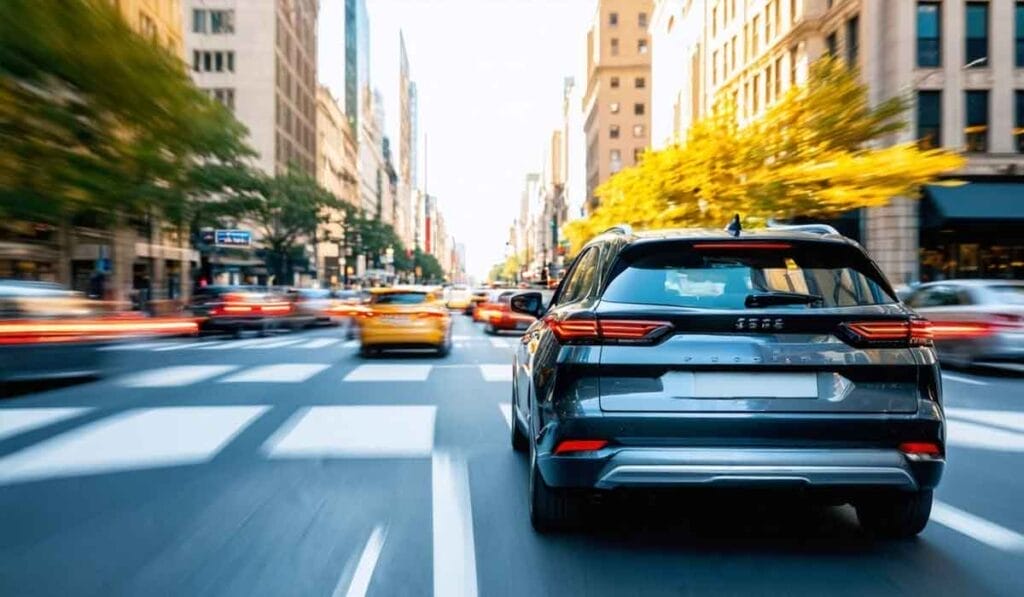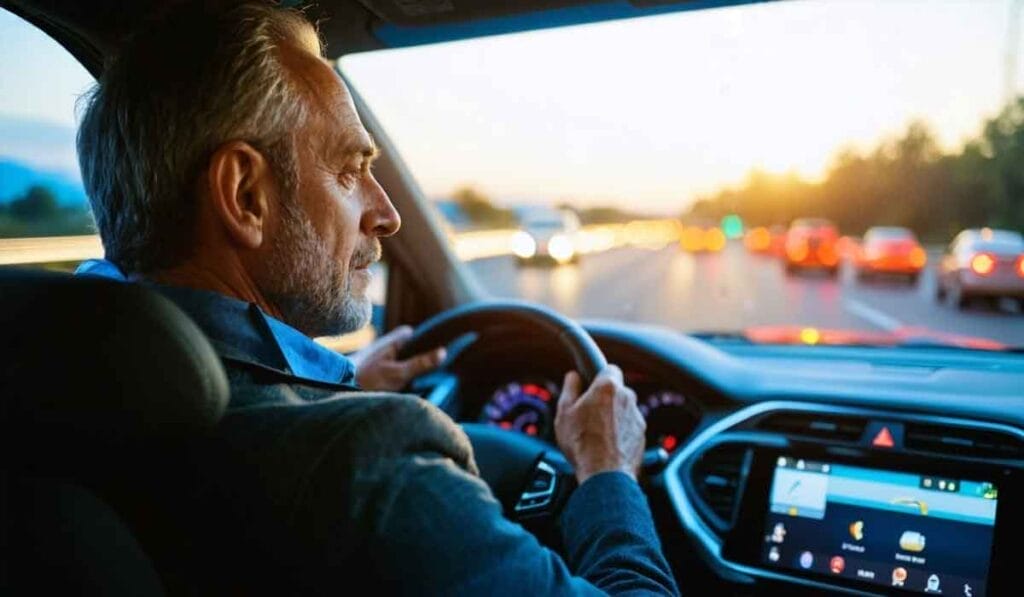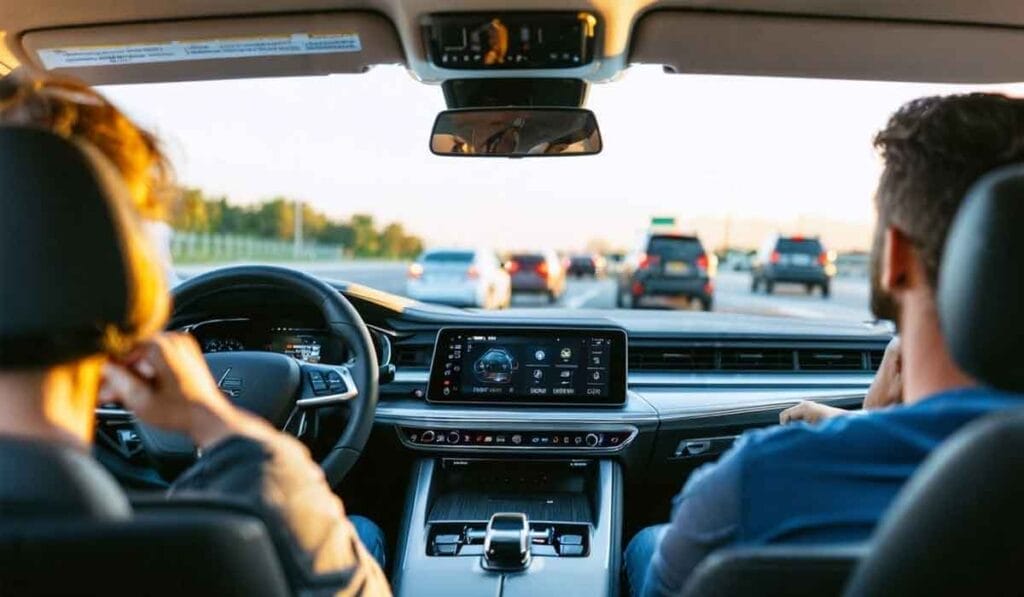Descubra la verdad: ¿Las características de seguridad del automóvil reducen los accidentes?
Conduces todos los días y te preguntas si tu coche es lo suficientemente seguro.
Un estudio realizado por la Instituto de Seguros para la Seguridad Vial muestra que Características de seguridad modernas poder reducir accidentes.
Este artículo le mostrará cómo funcionan cosas como frenado automático y advertencias de puntos ciegos Hacer la diferencia.
Tenga en cuenta: Somos médicos de accidentes que le cobramos $0 de su bolsillo por la mejor atención médica después de un accidente automovilístico.
Deberías venir y ser tratado por nosotros primero, y luego permítanos referirlo a los mejores abogados de accidentes automovilísticos en Phoenix o Mesa.
Conclusiones clave
Eficacia de las características de seguridad
- Las características de seguridad modernas reducen significativamente las tasas de accidentes.
- El frenado automático de emergencia (AEB) reduce los choques traseros hasta en un 50%.
- Los airbags son obligatorios desde la década de 1990 y han salvado miles de vidas.
- Las tecnologías avanzadas mejoran la seguridad y los hábitos de conducción en general.
Tecnologías de seguridad clave
Sistemas de bolsas de aire:
- Incluye bolsas de aire frontales, laterales, de rodillas y de cortina.
- Trabajar en conjunto con los cinturones de seguridad.
- Proteger contra lesiones en la cabeza y el pecho.
Frenado automático de emergencia:
- Detecta posibles colisiones.
- Aplica los frenos automáticamente.
- Reduce la gravedad de los accidentes.
- Utiliza sensores y cámaras para la detección.
Detección de puntos ciegos:
- Monitorea los lados del vehículo.
- Proporciona advertencias durante los cambios de carril.
- Reduce los accidentes por roce lateral.
Consideraciones financieras
- Las características de seguridad pueden generar tarifas de seguro más bajas.
- Valores de reventa más altos para vehículos con características de seguridad avanzadas.
- Los costos iniciales varían según la característica y el modelo del vehículo.
- Los beneficios a largo plazo a menudo superan los costos iniciales.
Impacto en la conducta al volante
- Las características de seguridad fomentan mejores hábitos de conducción.
- Las tecnologías complementan pero no reemplazan las prácticas de conducción segura.
- Las características mejoran la conciencia del conductor y los tiempos de reacción.
- Diferentes características se adaptan a distintos estilos y condiciones de conducción.
Descripción general de las funciones avanzadas de seguridad del automóvil

Los autos ahora cuentan con herramientas increíbles para mantenerte seguro en la carretera. Estas funciones, como las bolsas de aire y el frenado automático, trabajan arduamente para prevenir accidentes antes de que ocurran.
Bolsas de aire
Los airbags son una característica de seguridad crucial del automóvil Diseñado para protegerte en caso de colisión.
Piense en las bolsas de aire como el mecanismo de defensa incorporado de su vehículo, que se despliegan en milisegundos durante un accidente para crear una protección entre usted y las superficies duras de su automóvil.
Funcionan junto con los cinturones de seguridad para reducir las lesiones, especialmente las lesiones graves en la cabeza y el pecho.
Las bolsas de aire frontales son estándar en todos los automóviles nuevos desde finales de la década de 1990, gracias a las regulaciones de la Administración Nacional de Seguridad del Tráfico en las Carreteras (NHTSA).
Las bolsas de aire laterales, que protegen la cabeza y el pecho en caso de colisiones laterales, también se han vuelto comunes.
La tecnología del airbag ha evolucionado significativamente a lo largo de los años.
Los vehículos actuales pueden incluir Sistemas avanzados como airbags de rodilla que ayudan a prevenir lesiones en las piernas y bolsas de aire de cortina que se despliegan desde arriba de los marcos de las puertas para proteger las cabezas de los ocupantes en caso de vuelcos o impactos laterales.
Estas innovaciones demuestran la seriedad con la que los fabricantes se toman la seguridad vial. Expertos en seguridad de Asesor de Forbes y Universidad Carnegie Mellon Resaltar el Eficacia de los sistemas de airbag para salvar vidas: se estima que han salvó decenas de miles desde su introducción.
Los cinturones de seguridad salvan vidas, pero combinados con las bolsas de aire, forman un dúo vital que Reduce significativamente las muertes por accidentes.
Frenado automático de emergencia

El frenado automático de emergencia (AEB) es un salvavidas en la carretera, ya que reduce las posibilidades de sufrir un accidente.
Vehículos equipados con AEB sense colisiones potenciales antes de que puedas siquiera notarlos.
Ellos automáticamente aplicar los frenos Si detectan una amenaza inminente, Reducir la gravedad de los accidentes o evitarlo por completo.
Esta tecnología combina varias sistemas sofisticados como sensores y cámaras Estar atento a los peligros que se avecinan.
El AEB de su automóvil trabaja incansablemente detrás de escena, ya sea que esté conduciendo por calles concurridas de la ciudad o por la autopista.
Es como tener un par de ojos extra enfocados exclusivamente en prevenir accidentes.
Y, en los casos en que los accidentes son inevitables, el AEB desempeña un papel fundamental en Disminuir la fuerza del impacto, protegiendo así a usted y a sus pasajeros de manera más eficaz.
Implementar funciones como el frenado automático de emergencia en su vehículo no solo aumenta su seguridad sino que también mejora la confianza general al conducir.
Abrazando esto sistema avanzado de asistencia al conductor Le permite afrontar las carreteras con mayor seguridad, sabiendo que cuenta con tecnología inteligente lista para intervenir en esos momentos inesperados.
Detección de puntos ciegos

La detección de puntos ciegos es un salvavidas en carreteras con mucho tráfico, ya que le alerta sobre vehículos que se esconden en zonas difíciles de ver.
Los espejos de tu coche no pueden captar todo, especialmente cuando otro vehículo se cuela en tu punto ciego.
Con esto sistema avanzado de asistencia al conductor, Los sensores monitorean los lados de tu automóvil.
Ellos Activar una advertencia—generalmente una luz o un pitido—si hay algo en el camino cuando intentas cambiar de carril.
Esto significa menos sorpresas y cambios de carril más seguros.
Piense en ello como si tuviera un par de ojos extra que vigila esos puntos difíciles alrededor de su vehículo.
Ya sea que esté conduciendo por la autopista o por calles concurridas de la ciudad, el monitoreo de puntos ciegos ayuda a evitar roces e incorporaciones incorrectas al detectar lo que podría pasar por alto.
No se trata sólo de evitar accidentes; se trata de conducir con confianza, sabiendo que tienes tecnología a bordo que vigila el peligro que acecha fuera de la vista.
Impacto de las características de seguridad en las tasas de accidentes
Las características avanzadas de seguridad de los automóviles desempeñan un papel fundamental a la hora de reducir la cantidad de accidentes de tráfico de los que oímos hablar todos los días.
No sólo nos protegen durante los accidentes sino que también ayudan a evitarlos por completo.
Reducción de incidentes de colisión

Los elementos de seguridad de los automóviles reducen significativamente el número de accidentes en nuestras carreteras.
Tomemos como ejemplo los sistemas de frenado automático de emergencia (AEB): estas maravillas de la tecnología moderna detectan posibles colisiones antes de que ocurran y aplican los frenos si usted no responde a tiempo.
Las estadísticas muestran que AEB puede Choques por la parte trasera inferior por hasta 50%.
Similarmente, asistente de mantenimiento de carril ayuda a mantener su vehículo centrado en su carril, reduciendo en gran medida el riesgo de accidentes por roce lateral causados por desviaciones.
Características de seguridad como detección de puntos ciegos y alerta de tráfico cruzado trasero Han cambiado el juego.
La detección de puntos ciegos le avisa cuando otro vehículo entra en su punto ciego, lo que hace que los cambios de carril sean más seguros.
La alerta de tráfico cruzado trasero es igualmente importante: le advierte sobre vehículos que se aproximan cuando sale marcha atrás de un espacio de estacionamiento o de una entrada, lo que es crucial para evitar esos molestos choques menores.
Estas herramientas pueden parecer simples pero juegan un papel importante para evitar accidentes cada día.
Junto con advertencias de colisión frontal y el control electrónico de estabilidad (ESC), estas innovaciones han hecho que conducir sea menos intimidante y más seguro que nunca.
Elegir un automóvil equipado con estas tecnologías podría significar la diferencia entre sufrir un accidente o evitarlo por completo.
Asegúrese de priorizar dichas características al seleccionar su próximo vehículo: no son solo comodidades, sino necesidades para carretera segura hoy.
Influencia en el comportamiento del conductor

Funciones de seguridad avanzadas para el automóvil como asistente de mantenimiento de carril, sistemas de advertencia de puntos ciegos, y control de crucero adaptativo tienen un gran impacto en la forma en que conduces.
Estas tecnologías están diseñadas para alertarlo sobre peligros potenciales y ayudarlo a mantenerse seguro en la carretera.
Con estas herramientas a su disposición, es posible que se vuelva más consciente de su entorno.
Fomentan hábitos de conducción más seguros recordándole que debe permanecer en su carril, estar atento a los peatones y mantener una distancia segura con respecto a otros vehículos.
Frenado automático de emergencia y sistemas de advertencia de colisión frontal También juegan papeles críticos.
Imagínese conduciendo por una autopista muy transitada; estos sistemas pueden detectar cuándo es probable que se produzca una colisión y alertarlo o aplicar los frenos automáticamente.
Esto no sólo ayuda a prevenir accidentes, sino que también enseña a los conductores a ser cautelosos y reaccionar rápidamente en situaciones peligrosas.
A medida que estas características se vuelven más comunes en los vehículos, los conductores aprenden a confiar en la tecnología como ayuda para prevenir colisiones de vehículos.
El uso de las señales de giro se convierte en algo natural cuando las ayudas para cambiar de carril suenan como recordatorios si se te olvida.
Las cámaras de respaldo hacen que dar marcha atrás sea más seguro al mostrar obstáculos ocultos, reduciendo aún más los accidentes.
Estos avances funcionan juntos para crear carreteras más seguras para todos al mejorar el comportamiento del conductor con el tiempo, haciendo que la atención y las reacciones rápidas sean parte de cada viaje.
Consideraciones a tener en cuenta al elegir características de seguridad

Elegir las características de seguridad de un automóvil no consiste únicamente en elegir la tecnología más reciente, sino también en sopesar las ventajas frente al precio y pensar en cómo se adaptan a su estilo de conducción.
Análisis de costo vs. beneficio
Para comprender la relación costo-beneficio de las características de seguridad del automóvil es necesario analizar en profundidad cómo estas tecnologías afectan su billetera y su bienestar en la carretera.
Analicemos esto, teniendo en cuenta su objetivo de garantizar la seguridad sin gastar una fortuna.
| Característica de seguridad del automóvil | Costo | Beneficio |
|---|---|---|
| Bolsas de aire | Alto costo inicial, el mantenimiento puede sumarse | Reducción significativa de muertes y lesiones graves en caso de colisión |
| Frenado automático de emergencia (AEB) | Costo moderado a alto, dependiendo del vehículo. | Reduce considerablemente la probabilidad y la gravedad de un choque frontal y trasero. |
| Detección de puntos ciegos | Varía, a menudo se combina con otros paquetes de seguridad. | Mejora las decisiones de cambio de carril, reduciendo el riesgo de colisiones laterales. |
| Inversión total en características de seguridad | Puede ser significativo, especialmente para modelos de alta gama. | Tranquilidad de espíritu, ahorros potenciales en seguros, y un mejor valor de reventa del vehículo. |
Invertir en estas características puede parecer un gasto inicial elevado.
Pero es fundamental sopesar eso frente al potencial de salvar vidas, reducir lesiones e incluso ahorrar dinero a largo plazo a través de primas de seguro más bajas y menos gastos relacionados con accidentes.
Las características de seguridad mejoradas también pueden aumentar el valor de reventa de su automóvil, convirtiéndolo en una inversión inteligente a largo plazo.
Aproveche los avances en tecnología de seguridad para vehículos. Si bien el precio inicial puede ser alto, los beneficios, que van desde la tranquilidad hasta ahorros financieros a largo plazo—son convincentes.
Su seguridad y la de sus pasajeros es primordial.
Invertir en estas características no solo lo protege a usted, sino que también contribuye a tener carreteras más seguras para todos.
Compatibilidad con los hábitos de conducción
Elegir lo correcto Características de seguridad para su automóvil Significa pensar en cómo conduces.
Si a menudo te encuentras en calles concurridas de la ciudad, Sistemas de detección de peatones y frenado automático Pueden salvar vidas.
Reaccionan rápidamente si alguien se interpone delante de su coche, mucho más rápido que un humano.
Para los conductores de carreteras, Asistente de mantenimiento de carril y avisos de salida de carril mantenerte seguro en tu carril cuando esos viajes largos te dificultan mantenerte concentrado.
Para las personas que viven en climas lluviosos o nevados, Control de tracción y frenos antibloqueo Son imprescindibles.
Estos sistemas ayudan a mantener el control en condiciones resbaladizas, haciendo que cada viaje sea más seguro.
Usando cámaras de visión trasera hace que estacionar sea más fácil y seguro al mostrar lo que hay detrás de usted, perfecto tanto para principiantes como para conductores experimentados en espacios reducidos.
Por último, hablemos de los puntos ciegos: son complicados para todos.
La detección de puntos ciegos se enciende cuando hay un automóvil escondido donde no puedes verlo, lo que reduce las posibilidades de roces al cambiar de carril.
Combinar estas tecnologías con sus desafíos de conducción diarios garantiza no solo un viaje más seguro, sino también tranquilidad cada vez que se abrocha el cinturón.
Cada función actúa como un par de ojos extra en la carretera, adaptado para complementar su experiencia única. hábitos de conducción perfectamente.
Conclusión

Las características de seguridad en los automóviles, como las bolsas de aire y los sistemas de frenado de emergencia, realmente marcan la diferencia.
Ellos reducir los accidentes y Salvar vidasEs como tener un par de ojos extra que nunca parpadea, siempre atento al peligro.
Pero recuerda: no se trata solo de la tecnología de tu auto: tu forma de conducir también juega un papel importante.
Las decisiones inteligentes al volante importan tanto como lo que está integrado en su vehículo.
Mantén esto en mente mientras emprendes el camino: cada La opción de seguridad adicional es un paso hacia la reducción de accidentes y viajes más seguros para todos.
preguntas frecuentes
1. ¿Cuáles son algunas de las características de seguridad del automóvil diseñadas para reducir los accidentes automovilísticos?
Las características de seguridad del automóvil incluyen sistemas avanzados de asistencia al conductor, tecnologías para evitar colisiones como sistemas de advertencia de colisión frontal y sistemas de frenado de emergencia, sistema de control de estabilidad (DSTC), advertencia de cambio de carril (LDW), asistencia para mantenerse en el carril (LKA) y sistemas de video de visión trasera.
2. ¿Cómo contribuyen los cinturones de seguridad a reducir los accidentes de tráfico?
Los cinturones de seguridad, como los cinturones de seguridad de tres puntos que combinan un cinturón de regazo y un arnés de hombro, desempeñan un papel crucial en la seguridad automotriz al asegurar a los pasajeros durante paradas repentinas o colisiones, disminuyendo así las posibles lesiones en accidentes automovilísticos.
3. ¿Pueden los asientos para niños ofrecer protección durante accidentes automovilísticos?
¡Por supuesto! Los asientos de seguridad para niños brindan protección específica para los pasajeros más jóvenes en caso de un accidente de tráfico, sujetándolos firmemente en su lugar para minimizar el movimiento y el impacto.
4. ¿El sistema de frenos antibloqueo ayuda a prevenir accidentes automovilísticos?
¡Sí! El sistema de frenos antibloqueo ayuda a mantener el control sobre el pedal del acelerador, especialmente en superficies resbaladizas, lo que puede prevenir muchos posibles accidentes automovilísticos.
5. ¿Los coches modernos vienen con sistemas para evitar accidentes?
¡De hecho, lo hacen! Los vehículos modernos suelen contar con sistemas para evitar accidentes, como alertas de tráfico cruzado, asistencia para el centrado del carril y frenos automáticos, que funcionan en conjunto para prevenir accidentes automovilísticos.
6. ¿Cómo se relaciona la conducción distraída con estas características de seguridad?
Si bien estos avances tecnológicos apuntan a mejorar la seguridad vial, es importante recordar que ninguna cantidad de tecnología puede compensar totalmente los hábitos de conducción seguros: evitar las distracciones es clave para maximizar su eficacia contra los incidentes automovilísticos.

